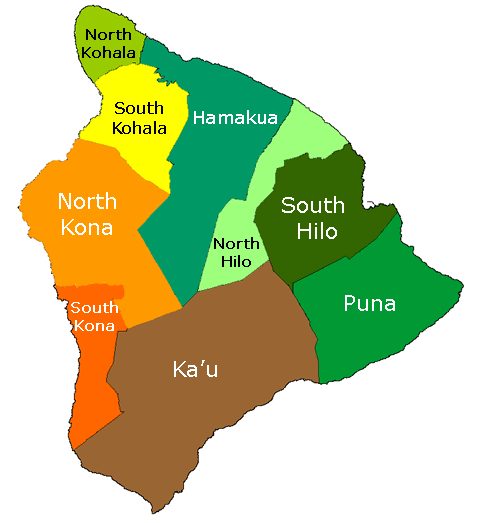Big Island of Hawaii Districts
Maybe after you have browsed through a Hawaii website, guidebook or newspaper you have come across Big Island district names, such as Hamakua Coast, Puna Coast, North Kohala, Kona Coast, etc., but wondered where these regions are actually located.
Visitors often wonder why all these names when it would be so easy to just refer to the different island regions as north shore, south shore, east shore and west shore. Well, the Big Island is the largest in the Hawaiian archipelago and each region has its distinct name.
The map below will give you an idea of all regions on the Big Island, so next time you read that a certain hotel, activity or point of interest is located for example on the South Kohala Coast, you'll know exactly where to find it on a map.

Hamakua
The Hamakua district is located on the Big Island's northeast shore, encompassing about 50 miles (80 km) of coastline. Popular visitor attractions in this area are Waipio Valley and Pololu Valley. Since the Hamakua Coast is located on the Big Island's windward coast, which receives a lot more rain than the leeward (west) coast, the landscape here is green and lush. The coastline consists of lava rock and there are no sandy beaches here. The plenty of rainfall has cut steep valleys into the cliffs, and the Mauna Kea volcano is another geographic feature of this region.
Hilo
The Hilo district is located on the Big Island's east shore, around the capital city of Hilo. Popular visitor attractions in this area are Hilo (there are many attractions within Hilo itself, such as museums, botanical gardens, beaches, etc.) and Rainbow Falls. Hilo is “America's wettest city,” thanks to 130 inches (3,302 mm) of rainfall per year. It is like one big greenhouse, a very lush city with green surroundings.
Puna
The Puna district is located on the Big Island's southeast shore. This region is known for its many freshwater springs and volcanically heated tide pools. In some areas one can experience cold spring water bubbling up from the ground and in other areas its hot water. A popular place for a unique bathing experience is Ahalanui Hot Pond, which is volcanically heated to a comfortable 90 F (32 C). Puna's coastline is entirely made up of lava rock and the district is lush.
Other visitor attractions in Puna are the charming little town of Pahoa, the Kalapana lava viewing area, New Kaimu Black Sand Beach and parts of Hawaii Volcanoes National Park. The eastern flank of the Kilauea volcano is located in the Puna district. Kilauea is the most active volcano in the world. That's why the Puna area is a high risk zone for volcanic and seismic activity. Despite that fact, Puna is experiencing the fastest growth rate of all the County of Hawaii districts, mainly because land is still relatively affordable here compared to many other areas in Hawaii. The population growth rate between 2000 and 2010 was 66%.
Ka'u
Ka'u is the southernmost district on the Big Island. It is also the largest one, containing much of Hawaii Volcanoes National Park, including the volcanoes Mauna Loa and Kilauea. Other visitor attractions in Ka'u are Punalu'u Black Sand Beach and Papakolea (Green Sand) Beach. In the past, Ka'u was covered in sugarcane plantations. Today, the main crop here is coffee.
South Kona
South Kona is located on the Big Island's southwest shore. Popular visitor attractions in South Kona are the Pu'uhonua o Honaunau National Historical Park and Kealakekua Bay. Kona means “leeward” (or dry side) in the Hawaiian language, as opposed to “ko'olau,” which means windward (or wet side). In the old Hawaii, the leeward coast of each Hawaiian island was called Kona. The climate in South Kona is ideal for growing coffee. Many coffee farms are located in this region, most of them small family farms growing the world-famous Kona coffee.
North Kona
North Kona is located on the Big Island's west shore. Popular visitor attractions in North Kona are Kailua-Kona (which itself has many cultural attractions, beaches, museums, etc.), Kaloko-Honokohau National Historical Park and Kekaha Kai State Park. Also, the world-famous Ironman World Championship Triathlon takes place each year in October in Kailua-Kona. North Kona, together with South Kohala, is the region where most Big Island visitors are headed. The majority of the accommodation options (hotels, resorts, vacation condos) are located here.
South Kohala
South Kohala is located on the Big Island's northwest shore. Popular visitor attractions in South Kohala are the white-sand Hapuna Beach, Mauna Kea Beach, Pu'ukohola Heiau and the inland town of Waimea (Kamuela), located in at an upcountry elevation of 2,670 feet (814 m).
Waimea is often times called “paniolo (cowboy) country” and is a fun place to visit especially on Independence Day (July 4) when the Parker Ranch rodeo and horse races take place here. The South Kohala coast is home to numerous luxury resorts, as well as championship golf courses.
South Kohala is the driest area on the Big Island. In fact, it is quite desert-like here with only 10 inches (254 mm) of rainfall per year.
North Kohala
North Kohala is located on the Big Island's north shore. Popular visitor attractions in North Kohala are the Lapakahi State Historical Park, Mo'okini Heiau and the birthplace of King Kamehameha the Great.














